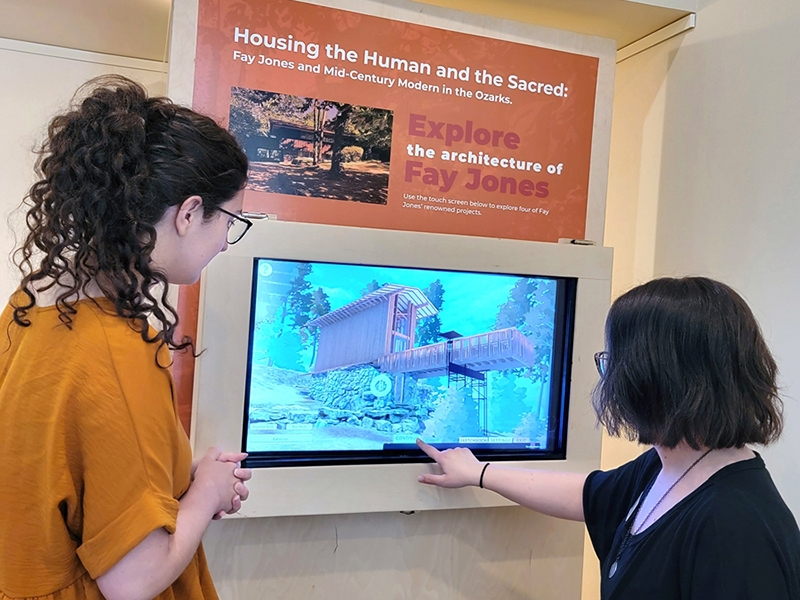
A new interactive kiosk exhibit exploring the work of the renowned architect Fay Jones, created by an interdisciplinary U of A faculty and student team, is now on display at the Shiloh Museum of Ozark History in Springdale.
Housing the Human and the Sacred: A Digital Experience of the Architecture of Fay Jones features interactive gaming technology using a touch screen, which enables visitors to explore Jones’ architecture in three dimensions.
The exhibit is free and open to the public, and on display now through Dec. 31 with a special lecture coming up on Wednesday, May 17.
The kiosk is one of the results of a project created to explore Jones’ work by a team of U of A students and faculty from the Fay Jones School of Architecture and Design and the Tesseract Center for Immersive Environments and Game Design in the Fulbright College of Arts and Sciences.
The project was led by Greg Herman, associate professor of architecture and director of the Fay and Gus Jones House Stewardship, and David Fredrick, associate professor of classical studies and director of the Tesseract Center.
“We are so pleased to partner with Greg, David and the U of A to provide a site for this interactive kiosk,” said Angie Albright, the Shiloh Museum’s director. “Fay Jones’ work is, of course, legendary in architecture circles, but it’s so reflective of the environment of the Ozarks and essential to understanding the changing architectural styles of the mid-century modern era locally.”
“The kiosk gives visitors the opportunity to interact with Jones’ work and get a sense of his creation process, something not possible through books and photos,” she added.
Albright said that in conjunction with the kiosk exhibit, Herman and Fredrick will be the featured speakers at 6:30 p.m. Wednesday, May 17, at the museum for its monthly “Not Strictly History” series.
Herman said he and Fredrick are looking forward to the talk and to seeing museum visitors interact with the kiosk to learn about Jones’ work.
“The work of Fay Jones is especially relevant to our rapidly growing region, but Jones’ work also appeals internationally,” he said. “It is a privilege to present Jones’ architecture to new audiences, allowing fresh insights into the work by many who may have never seen his work before.”
Fredrick agreed, adding that “Fay Jones uses a humble palette — stone, wood, glass, water, light — to achieve transcendent results.”
“It was a challenging and exhilarating experience to work with U of A students to translate this architecture into an interactive digital environment, recognizing that video games now tackle serious subjects, and the poetic architecture of Fay Jones can be one of those subjects,” he said.
Fay Jones, namesake of the Fay Jones School and an Arkansas native, was a member of the U of A’s first graduating class of architecture students in 1950. He later taught there for 35 years and served as the School of Architecture’s first dean.
Jones also earned an international reputation for his design work, which typically utilized simple elements, such as stone, wood and glass.
The American Institute of Architects awarded Jones the prestigious AIA Gold Medal in 1990. Later, it honored Jones as one of the country’s “10 most influential living architects” and ranked his masterwork, Thorncrown Chapel, as the fourth best building by an American architect in the 20th century. Jones died in Fayetteville in 2004 at the age of 83.
The kiosk project was supported by a Chancellor’s Innovation and Collaboration Fund grant from the U of A and a Digital Projects for the Public Grant from the National Endowment for the Humanities.
The kiosk exhibit featuring Jones’ work, Housing the Human and the Sacred: A Digital Experience of the Architecture of Fay Jones, will be on display through Dec. 31 at the Shiloh Museum of Ozark History, located at 118 W. Johnson Ave.
Museum hours are 10 a.m. to 5 p.m. Monday through Saturday. For more information, call (479) 750-8165.
About the University of Arkansas: As Arkansas' flagship institution, the U of A provides an internationally competitive education in more than 200 academic programs. Founded in 1871, the U of A contributes more than $2.2 billion to Arkansas’ economy through the teaching of new knowledge and skills, entrepreneurship and job development, discovery through research and creative activity while also providing training for professional disciplines. The Carnegie Foundation classifies the U of A among the few U.S. colleges and universities with the highest level of research activity. U.S. News & World Report ranks the U of A among the top public universities in the nation. See how the U of A works to build a better world at Arkansas Research News.
Topics
Contacts
Michelle Parks, senior director of marketing and communications
Fay Jones School of Architecture and Design
479-575-4704,
mparks17@uark.edu
Andra Parrish Liwag, development writer
Fulbright College of Arts and Sciences
479-575-4393,
liwag@uark.edu